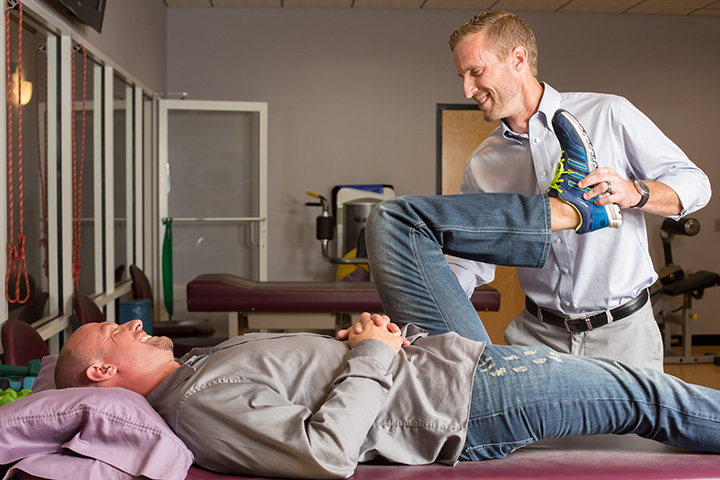Having a hip injury can express itself in a lot of ways — hip pain, groin pain, stiffness, or even a clicking feeling. If you’re experiencing any of these symptoms but are not able to get a diagnosis, you may have a hip labral tear.
What is a hip labral tear?
The hip is shaped like a ball and socket. The socket is called the acetabulum, and the soft tissue that covers the acetabulum is the labrum. The hip labrum lubricates the joint, acts as a shock absorber, distributes pressure and aids in stability. The blood supply to the labrum is limited, so once the labrum is damaged, it lacks the ability to heal.
Hip labral tears are fairly common. Among patients with hip or groin pain, hip labral tears were reported in up to 55%, according to research published in Current Reviews in Musculoskeletal Medicine.

Types of hip labral tears
Labral tears are classified by how they occur and where they occur:
- Traumatic: Caused by an acute injury
- Degenerative: Caused by repetitive wear and tear over a long period of time
- Anterior tears: Facing the groin, which is the most common location
- Posterior tears: Facing the buttocks
What does a hip labral tear feel like?
A hip labral tear can have the following symptoms:
- Pain in the buttocks and groin on the injured side
- A sound or feeling of clicking or locking when the hip is in motion
- Stiffness or pain while moving or rotating the hip
What causes a hip labral tear?
There are many causes, including:
- Hip impingement, or Femoroacetabular impingement (FAI) is the most common cause of labral tears. In hip impingement, the hip joint is malformed, causing friction that damages the joint over time. The damage to the cartilage caused by this friction can lead to a torn labrum.
- Hip dysplasia, or other structural abnormalities, can also increase the risk of an individual to have a labral tear.
- Traumatic events, such as a fall or collision with another player during sports or a motor vehicle accident, can result in labral tears.
- Sports that involve a lot of repetitive rotational motion and pivoting, such as tennis, karate, hockey, football or soccer, can contribute to a labral tear, according to Clinical Orthopaedics and Related Research
- Hip osteoarthritis involves the breaking down and damaging of the cartilage which can lead to bone-on-bone contact in the hip. Labral tears can contribute to the progression of hip osteoarthritis.
- Repetitive motions over time, in the hip, can also lead to a labral tear.
Research reports that labral tears occur more frequently in women than in men, which may be due to the increased incidence of hip dysplasia in women.
How is a hip labral tear diagnosed?
A hip labral tear can be difficult to diagnose because the hip is surrounded by different tissues and muscles. They are often misdiagnosed as common groin strains, or the diagnosis can be missed for months after the labrum is torn.
An experienced orthopedist will first conduct a physical exam and evaluate your symptoms. They may move your leg into different positions to check for pain and evaluate the hip’s range of motion. The FADIR (Flexion, Abduction, and Internal Rotation) test is a standard way of checking for a hip labral tear.
After a physical exam, imaging tests may be ordered, including:
- X-ray: An X-ray can identify any associated structural abnormalities such as hip impingement or hip dysplasia.
- MRI: An MRI is the best imaging test to confirm the diagnosis of a labral tear due to its level of detail. An MRI can also help rule out other issues, such as tendon avulsions or sports hernias.
- Diagnostic injection: Injecting an anesthetic directly into the hip joint can confirm that the pain you are experiencing is caused by the joint, according to NYU Langone Health.
What is the treatment for a hip labral tear?
Nonsurgical treatment
Activity modification
Limiting activities that bring on hip pain, such as sports that required repeated hip rotation, can stop irritation in the labrum.
Medication
Anti-inflammatory medications and pain medications are typically recommended as the first form of treatment for a labral tear. Ibuprofen (Motrin, Advil) and naproxen sodium (Aleve) can help relieve pain and reduce inflammation.
Physical therapy
An experienced physical therapist can work with you to address the issues that put the hip at risk for a labral tear in the first place. They can teach you strengthening exercises as well as the movements to avoid that put stress on the hip joint.
Corticosteroid injection
Corticosteroid injections can help reduce swelling in the hip joint, which can limit hip pain.
Surgical treatment
If nonsurgical treatments are not effective, hip arthroscopic surgery can repair the labral tear. According to Dr. Vladimir Alexander, Founding Partner of Alexander Orthopaedics, “We go into the hip arthroscopically, we clean up the labrum or stitch the labrum back together depending one what the findings are, and we reshape the socket and/or the head of the femur.”
What is the hip labral tear recovery process?
You don’t have to live with pain. Our experienced team of physicians and physical therapists work with you one-on-one to create an individualized treatment plan that will help you recover as quickly as possible.
Schedule an appointment today and we will contact you within 24 hours to discuss your hip labral tear treatment plan.
